 SynLube™ Lube‑4‑Life®
SynLube™ Lube‑4‑Life®
 SynLube™ Lube‑4‑Life®
SynLube™ Lube‑4‑Life®
HOME | Contact Us | How to Order | PRICE LIST | Sitemap | Publications | FAQ | LINKS
Products | Motor Oil | ATF | Gear Oil | PSF | Grease | Coolant | Oil Filters | Magnets | Brake Fluid
Company: Profile | History | Associations | Mission | News | Press Releases
Product: Guarantee | Oil Comparison | SynLube Uses | No Oil Change | Long Term Tests | Warranty
SynLube™ Lube‑4‑Life® reduces Friction and Wear; which makes any lubricated equipment last longer in service.
How is that possible?
It can be understood by looking at the Mechanical Friction Losses of a typical Piston Engine as well as the Stribeck Curve of the lubricant base oils when compared to SynLube™.
Friction Losses in the engine account for about 10% to as
much as 15% of the energy that is available in Fuel, such as Gasoline
(Petrol, Benzin) or Diesel Fuel.
In really inefficient engine designs the Mechanical Friction
Losses can be as much as 20%.
While in the most Modern Low Friction Engines, the losses still account for about 7% to 9%.
Mechanical Friction Losses in Piston Engines consist of following:
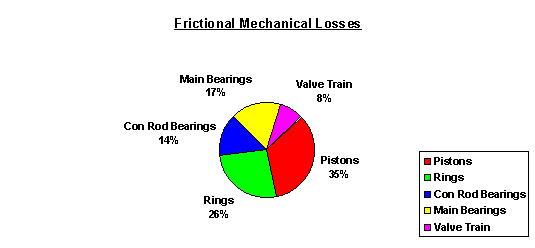
The above pie chart shows the distribution of
the Mechanical Friction Losses in a typical engine.
Before we discuss each of the above systems, it is important to introduce
another concept, the different types of Lubrication Contact and their effect on
Friction Coefficient and Wear.
They are:
The relationship of different lubrication regimes can be expressed
graphically and it is called the
"Stribeck Curve".
The graph below shows the relationship between the Friction Coefficient and Sliding Speed.
However Oil Viscosity and Load also have an effect and can be expressed by formula:
Friction Coefficient = ( Oil Viscosity * Velocity ) / Load
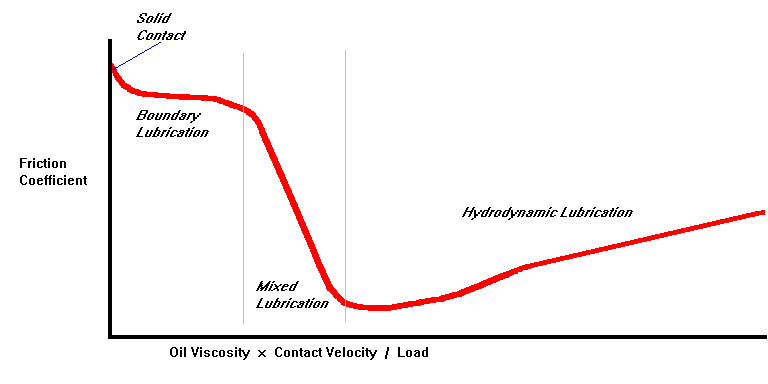
Solid Contact is a stationary condition where there is intimate contact between two surfaces.
They are interlocked by the surface roughness on each.
The Friction Coefficient is at its maximum.
The value of this condition is expressed as Static Coefficient of Friction.
It is also called "Stiction", because the two surfaces literally stick to each other.
The higher is the Static Coefficient of Friction or Stiction the more force it requires to move the two surfaces in relation to each other.
Because there is no movement, there is no Wear.
Because the two surfaces are stationary and interlocked by the surface roughness there is no Separation between the two surfaces.
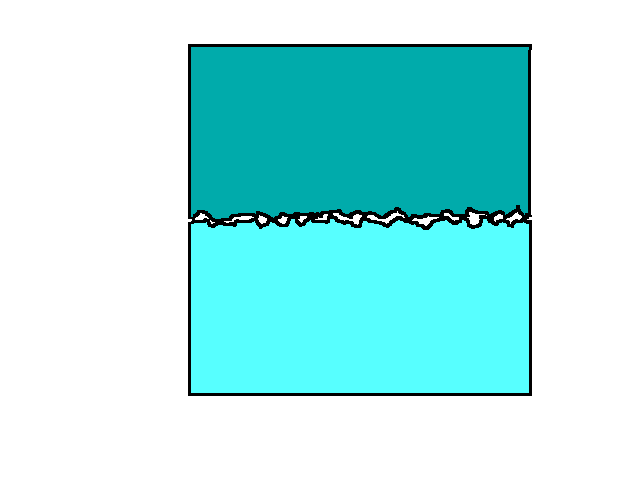
Boundary Lubrication occurs when there is slow movement and when the two bearing surfaces are no longer interlocked but also not completely separated.
The peaks of the surface roughness hit each other and as a consequence high Friction and high Wear results.
Such lubrication condition exists during start-up.
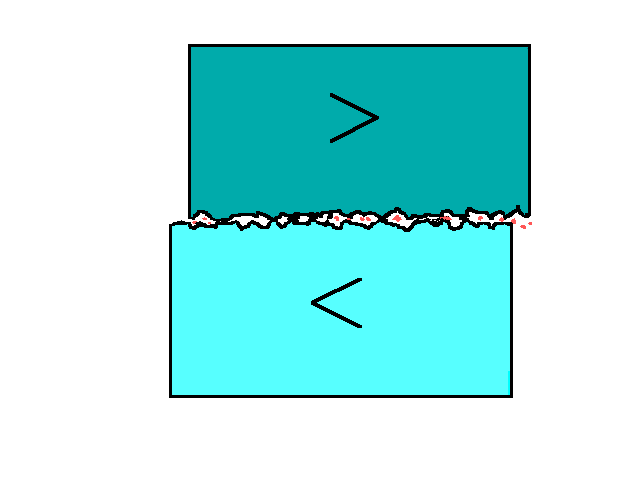
Mixed Lubrication occurs when lubricant film is so thin or load so high that the lubricant can not completely separate the two bearing surfaces.
Some minimal surface roughness contact occurs and this causes low Wear.
As the Separation distance between the two bearing surfaces increases the Friction Coefficient rapidly decreases.
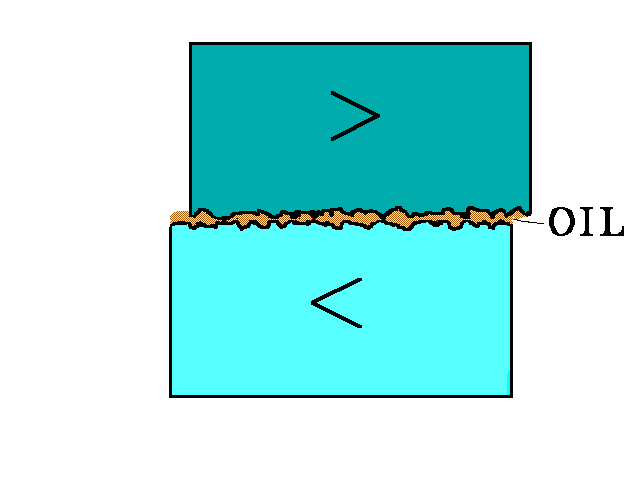
Hydrodynamic Lubrication occurs when the bearing surfaces are completely separated by an oil film that is thicker than the surface roughness.
Under such condition the Friction is low and is affected only by the Viscosity of the Oil.
Because there is no contact between the bearing surfaces there is no Wear.
As the sliding velocity is increasing the Oil Viscosity causes slight increase in the Coefficient of Friction
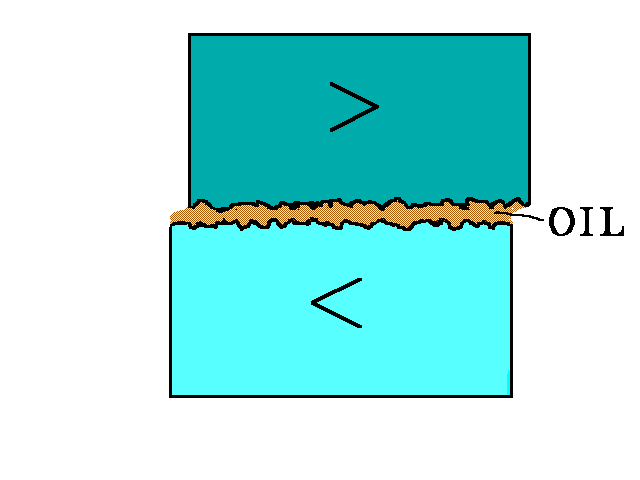
What makes SynLube™ Lube‑4‑Life® different ?
Now that you understand the terms and functions of conventional liquid oil lubrication, you are ready for advanced lesson in Tribology - Sol Lubrication.
Sol Lubrication occurs when the bearing surfaces are completely separated by an oil film that contains colloidal particles which are larger in diameter than the surface roughness.
Under such condition the Friction is low and is affected only by the Viscosity of the Sol.
Because there is no contact between the bearing surfaces there is no Wear.
As the sliding velocity is increasing the Sol Viscosity causes slight increase in the Coefficient of Friction.
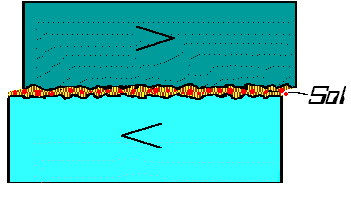
Why is Sol Lubrication such Important Concept ?
Key Points comparison between conventional and Sol Lubrication.
Stribeck
Curve for Conventional Liquid Petroleum Oil Lubricant
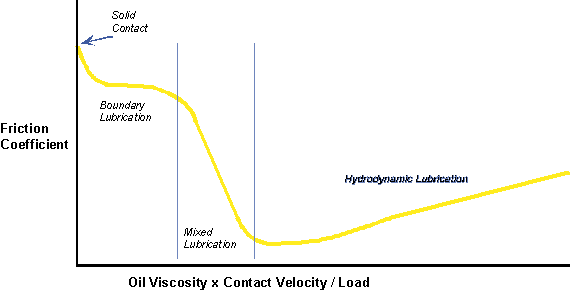
Key Features:
Stribeck Curve for SynLube™Lube‑4‑Life® Lubricant
(Oil Lubricant curve from above shown for comparison)
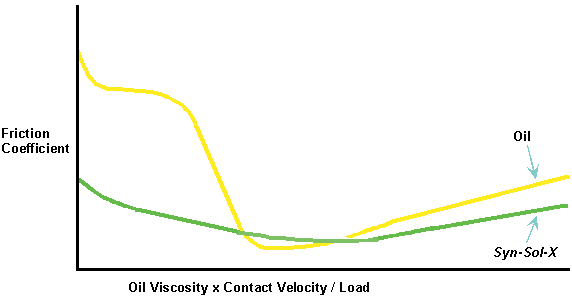
Key Features:
NO MAGIC HERE - Just plain Tribo-Mechanical Fact
So to sum it all up, SynLube™ Lube‑4‑Life® at first eliminates Stiction therefore mechanisms start easier and faster, secondly because of the typically lower average Friction Coefficient when compared to conventional liquid lubricants, less energy in needed to overcome equipment's Mechanical Friction. This results in lower operating, better Fuel Economy as well as longer equipment service life.
SynLube™ Lube‑4‑Life® lasts even longer in service than suggested by Arrhenius equation alone.
The MAGICAL RESULT?
Lower Friction, Lesser Wear and Much Longer Vehicle and Equipment Service Life !
SynLube™ Lube‑4‑Life® is the only space age Motor Oil on the market that is not just capable, but proven to provide excellent engine protection as well as engine longevity with oil changes as seldom as every 15 years / 150,000 miles (240,000 Km).
However for purpose of our SynLube™ Lube‑4‑Life® Limited Lubrication Warranty, we take more conservative approach and require that the used SynLube™ Lube‑4‑Life® is either replaced or a sample is submitted to SynLube Incorporated every 5 years or 50,000 miles.
SynLube Incorporated then test the used SynLube™ Lube‑4‑Life® Motor Oil using a proprietary oxidation test to determine if it is suitable for further use, or if indeed it can be used for as long as 15 years or 150,000 miles (240,000 km).
Here are LINKS to other pages on our web that explain the SynLube™ Lube‑4‑Life® MAGIC in detail:
HOME | Motor Oil | ATF | Gear Oil | PSF | Grease | Coolant | Oil Filters | Magnets | Brake Fluid | Gauges | Tools | Specials | Sale Items